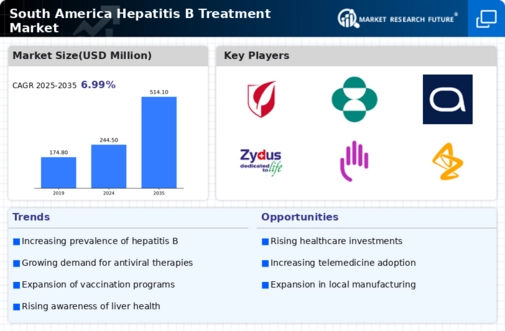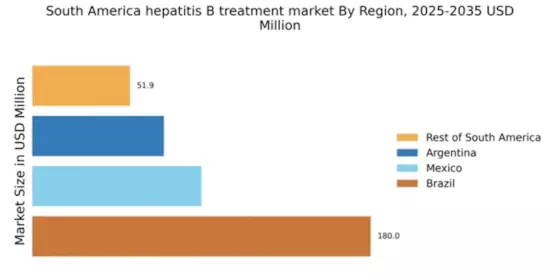Rising Incidence of Hepatitis B
The increasing incidence of hepatitis B in South America is a critical driver for the hepatitis b-treatment market. According to health statistics, the region has witnessed a notable rise in reported cases, with estimates suggesting that approximately 1.5 million individuals are currently living with chronic hepatitis B. This growing patient population necessitates enhanced treatment options and healthcare services, thereby propelling market growth. The hepatitis b-treatment market is likely to expand as healthcare providers focus on developing and implementing effective treatment protocols to manage this rising burden. Furthermore, the increasing prevalence of hepatitis B is prompting governments and health organizations to allocate more resources towards prevention and treatment initiatives, which could further stimulate market dynamics.
Government Initiatives and Funding
Government initiatives aimed at combating hepatitis B are significantly influencing the hepatitis b-treatment market in South America. Various countries in the region have launched national programs to increase screening, vaccination, and treatment accessibility. For instance, Brazil has implemented a comprehensive hepatitis B vaccination program, which has led to a substantial decrease in new infections. Additionally, funding from governmental and non-governmental organizations is being directed towards research and development of innovative treatment options. This financial support is crucial for the hepatitis b-treatment market, as it enables the introduction of new therapies and enhances the overall healthcare infrastructure. As a result, the market is expected to benefit from increased investment in hepatitis B management strategies.
Rising Demand for Innovative Therapies
The rising demand for innovative therapies is a significant driver of the hepatitis b-treatment market in South America. Patients and healthcare providers are increasingly seeking advanced treatment options that offer improved efficacy and safety profiles. Recent developments in antiviral therapies and immunotherapies are capturing attention, as they promise better management of chronic hepatitis B. The hepatitis b-treatment market is poised for growth as pharmaceutical companies invest in research and development to meet this demand. Furthermore, the increasing awareness of treatment options among patients is likely to drive market expansion, as individuals become more proactive in seeking effective therapies for hepatitis B.
Technological Advancements in Diagnostics
Technological advancements in diagnostic tools are playing a pivotal role in shaping the hepatitis b-treatment market. The introduction of rapid and accurate diagnostic tests has improved the detection rates of hepatitis B, allowing for earlier intervention and treatment. In South America, the adoption of these advanced diagnostic technologies is becoming more prevalent, which is likely to enhance patient outcomes. The hepatitis b-treatment market is expected to grow as healthcare providers increasingly rely on these innovations to identify and manage hepatitis B cases effectively. Moreover, improved diagnostics can lead to better patient stratification, enabling tailored treatment approaches that could further optimize therapeutic efficacy and resource allocation.
Increased Collaboration Among Stakeholders
The hepatitis b-treatment market in South America is experiencing growth due to increased collaboration among various stakeholders, including governments, healthcare providers, and pharmaceutical companies. This collaborative approach is fostering the development of comprehensive strategies to address hepatitis B management. For instance, partnerships between public health organizations and private sector entities are facilitating the sharing of resources and expertise, which is essential for enhancing treatment accessibility. The hepatitis b-treatment market is likely to benefit from these synergies, as they can lead to the establishment of more effective treatment programs and awareness campaigns. Such collaborations may also drive innovation in treatment options, ultimately improving patient care and outcomes.


















Leave a Comment